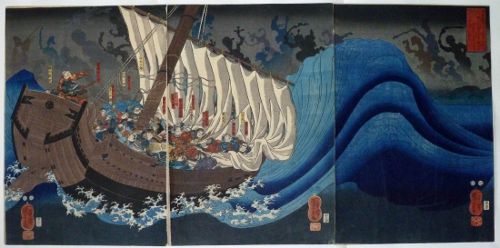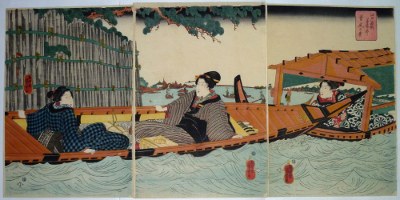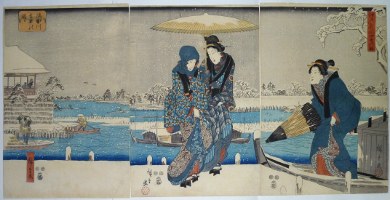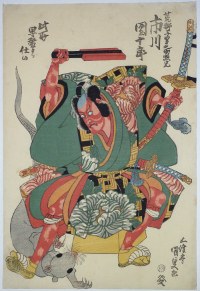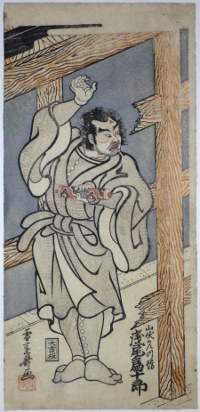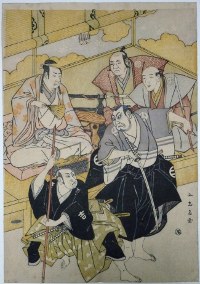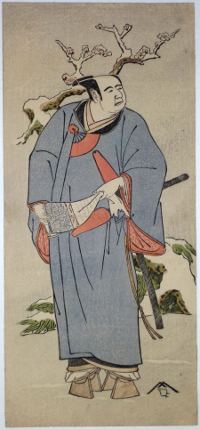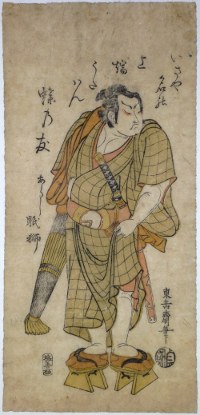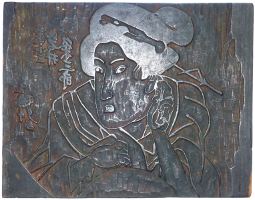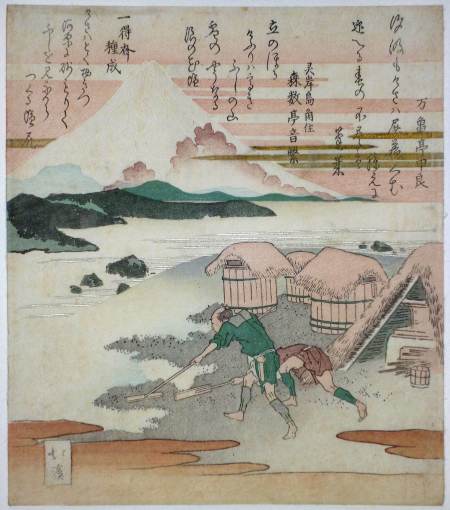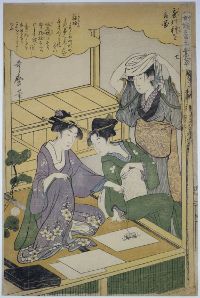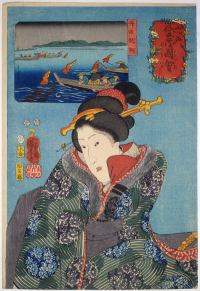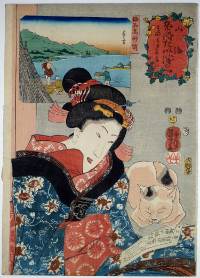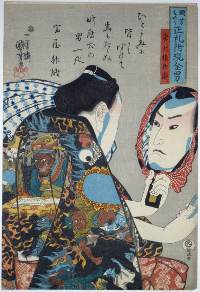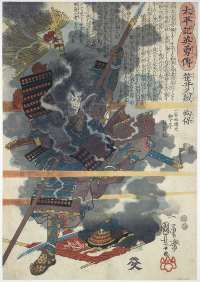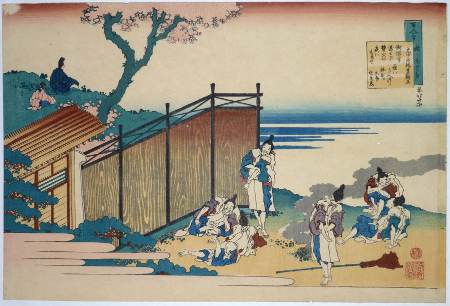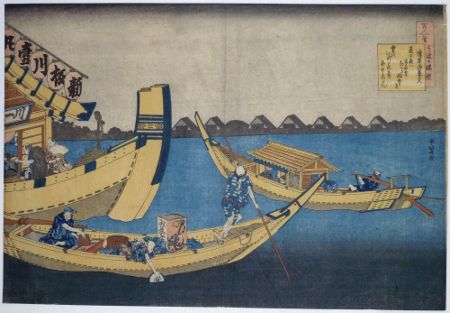Tsukioka YOSHITOSHI (1839-1892)
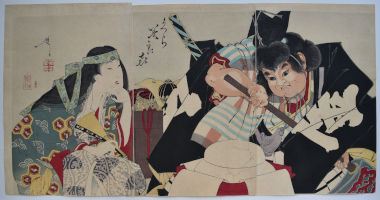
Click here to view image full size.
A triptych showing Yamauba on the left and Kintaro about to wield a large axe to break a large Kaga mimochi, mirror rice cake. This is a traditional Shinto rite in January. January 11th is also the day the wealthy opened their storehouses to air their precious possessions (Kurabiraki). Published by Akiyama Buemon 1891.
Very fine impression with extensive burnishing. Fine colour and condition. Signed Yoshitoshi.
Status: Sold
Tsukioka YOSHITOSHI (1839-1892)
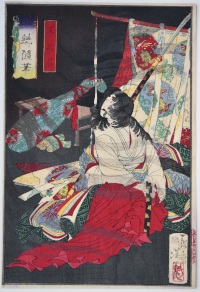
Click here to view image full size.
Yodo-no-Kimi (aka Yodogimi), the concubine and second wife of the daimyo Toyotomi Hideyoshi, readies herself for seppuku: Hideyoshi, having died, she and her son are thought to pose a threat to Tokugawa Ieyasu who had become a guardian of Hideyoshi’s son. They hold up in Osaka castle where they commit suicide, rather than be captured. From the set Ikkai zuihitsu, “Essays by Yoshitoshi.” (Ikkai was an early name of Yoshitoshi’s.) A set of thirteen prints published by Masadaya Heikichi 1872/3. A fine set.
Extremely fine impression and colour from the first edition. Most designs from the set have red seals in the margin and red seals over the signature. These were removed on later editions. Margins trimmed a little, otherwise fine condition. Signed Ikkaisai Yoshitoshi hitsu. d on later editions. Trimmed on black border at left, otherwise fine condition. Signed Ikkaisai Yoshitoshi hitsu.
Status: Sold
Tsukioka YOSHITOSHI (1839-1892)
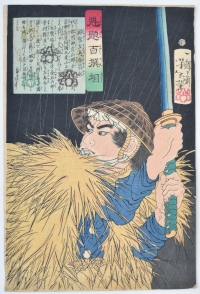
Click here to view image full size.
The warrior Jingu Samanosuke Masanaga holding a sword and wearing a mino (straw cape) in heavy rain. From a set Kaidai hyaku, “Yoshitoshi’s Selection of One Hundred Warriors.” Sixty-five prints published by Ohashiya Yashichi between 1868 and 1869, this being 1869. The text in the square cartouches in this set refer to prominent warriors in the internecine wars of the 16th century but in fact the subjects are Shogitai soldiers. (Those that held out against the imperial forces and were massacred at Ueno, 4/7/1868.) An excellent set.
Fine impression and colour. The rain printed in silver. Fine condition. Signed Ikkaisai Yoshitoshi htsu.
Status: Sold
Tsukioka YOSHITOSHI (1839-1892)
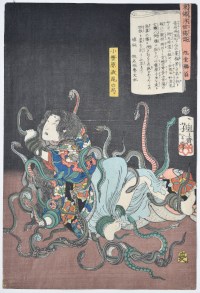
Click here to view image full size.
A design from the set Azuma no nishiki ukiyo kodan, “Tales of the Floating World on Eastern Brocade.” Kodan (traditional storytelling) raconteurs narrated Japanese folk stories, sometimes accompanying themselves with wooden blocks clapped together or a fan giving rhythm. The Kodan text is shown above. Having been popular from around 1700 (and known as Koshaku), these performances gained renewed popularity in the 1850s with the classic standards augmented by contemporary stories of heroes and villains. Shows Lady Masao from Osasahara surrounded by curling snakes who force her to reveal her true identity – the Fox Spirit. Various publishers from 1867-68, here Omiya Kyojiro, 11/1867.
Fine impression. Very good colour. Slight trimming, otherwise very good condtion. Signed Ikkaisai Yoshitoshi hitsu.
Status: Sold
Tsukioka YOSHITOSHI (1839-1892)
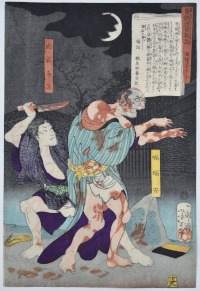
Click here to view image full size.
A design from the set Azuma no nishiki ukiyo kodan, “Tales of the Floating World on Eastern Brocade.” Kodan (traditional storytelling) raconteurs narrated Japanese folk stories, sometimes accompanying themselves with wooden blocks clapped together or a fan giving rhythm. The Kodan text is shown above. Having been popular from around 1700 (and known as Koshaku), these performances gained renewed popularity in the 1850s with the classic standards augmented by contemporary stories of heroes and villains. Shows Mukokizu Yosa stabbing Komori Yasu (Yasu the Bat); so-called because of the bat-like birthmark on his cheek. A gruesome scene with Yasu covered in blood. Various publishers from 1867-68, here Omiya Kyojiro, 11/1867.
Fine impression. Very good colour. Slight trimming, otherwise very good condtion. Signed Ikkaisai Yoshitoshi hitsu.
Status: Sold
Tsukioka YOSHITOSHI (1839-1892)
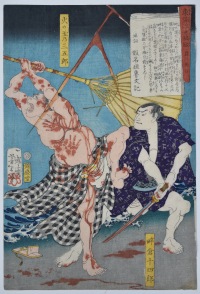
Click here to view image full size.
A design from the set Azuma no nishiki ukiyo kodan, “Tales of the Floating World on Eastern Brocade.” Kodan (traditional storytelling) raconteurs narrated Japanese folk stories, sometimes accompanying themselves with wooden blocks clapped together or a fan giving rhythm. The Kodan text is shown above. Having been popular from around 1700 (and known as Koshaku), these performances gained renewed popularity in the 1850s with the classic standards augmented by contemporary stories of heroes and villains. Shows Azekura Jushiro slashing Hinotama no Sangoro who is covered in blood. Various publishers from 1867-68, here Sanoya Tomigoro, 9/1867.
Fine impression. Very good colour. Slight trimming, otherwise very good condtion.
Status: Sold
Utagawa KUNIYOSHI (1797-1861)
Click here to view image full size.
A triptych showing the ghosts of the Taira (Heike) warriors attempting to sink Yoshitsune’s ship off the coast of Settsu on his way to Shikoku. This is one of Kuniyoshi’s great designs – amongst the three or four best triptychs and is illustrated in numerous publications. The scene is the outcome of a great battle at Dan-no-ura where the Minamoto (Genji) clans clashed and defeated the Taira clans a few years earlier. The spirits of the drowned warriors rose up to seek revenge only to be pacified by Benkei reciting exorcisms with his rosary. Published 1849-52 by Enshuya Hikobei. Robinson T242. Rare.
Very good impression and colour although slightly mismatched blue on the first and second sheets. Very good condition. Full size. There appear to be three states of this design: The main difference being in the shape of the ghosts and lines in the waves only on the first state. In this (the second state) the ghosts lack some of the features that are on the first and a large spirit appears above the wave over the ship on the centre panel. The third state has further differences in the ghosts and lacks this figure. Also, the colour of the boat gets greyer. Signed Ichiyusai Kuniyoshi ga.
Status: Sold
Yurakusai NAGAHIDE (c 1799-1848)
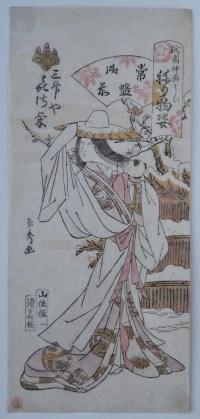
Click here to view image full size.
An hosoban kappazuri (coloured by stencils) print from a set: Gion mikoshi arai nerimono sugata, “Gion Festival Costume Parade.” The set was jointly designed by: Goshichi, Seikoku (Charakusai) and Toyokuni, as well as Nagahide, although he appears to have been responsible for many in the set. A large group is in the MFA, Boston, with another impression of this design being acc. no 11.26554. Published by Yamashiroya Sahei (Yamasa) c 1818. Shows a courtesan, Kisae of Mimasuya, parading in the Gion Matsuri Festival, held in the geisha quarter of Kyoto in July, dressed as Tokiwa Gozen, the mother of Minamoto no Yoshitsune. She is usually depicted fleeing through the snow during the Heiji rebellion cradling her son to her chest. Seal bottom left Kato [Shozo] who was an art dealer/collector in Oxford Street, London and sold prints to the BM in the 1920s.
Very good impression with extensive undamaged mica. Very good colour. Signs of mounting au verso, otherwise very good condition. Signed Nagahide ga.
Status: Sold
Utagawa TOYOKUNI (1769-1825)
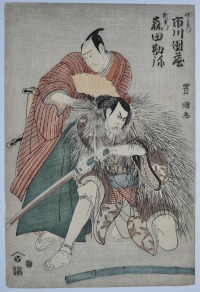
Click here to view image full size.
Shows Ichikawa Danzo IV as Shundo Jiroemon disguised as a beggar and Morita Kan’ya VIII as Takaichi Buemon in the Daianji Zutsumi scene from the play Katakiuchi tsuzure no nishiki, “The Vendetta in Patched-Brocade.” A fine grey-ground print published by Eijudo, 1798. Ichikawa Danzo IV had one of the great Kabuki faces. See the 1799 Toyokuni bust of Danzo as Keyamura Rokusuke in the drama Hikosan Gongen Chikai no Sukedachi.
Fine impression. Very good colour and condition. Signed Toyokuni ga.
Status: Sold
Torii KIYONOBU II (Fl. c 1720s-1760)
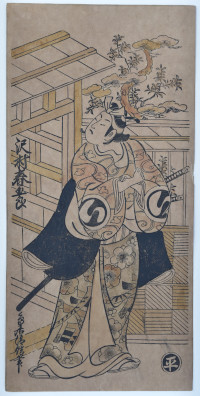
Click here to view image full size.
An early print showing the actor Sawamura Harugoro as Soga no Goro. Another impression is in MFA, Boston, acc. no. 21.5656. Published by Hiranoya Kohachi c early 1740s. Ex collection Dr E.F. (1969). Rare.
Very good impression. Urushi beni-e with signs of hand-colouring (faded) and lacquered sumi. Paper toned and signs of mounting au verso. Signed Torii Kiyonobu hitsu.
Status: Sold
Katsukawa SHUN’EI
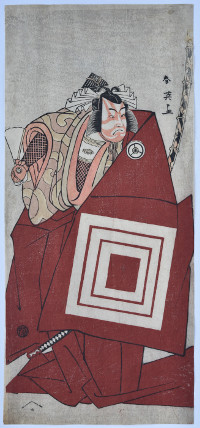
Click here to view image full size.
An hosoban showing Iwai Hanshiro IV in a “Shibaraku” role, probably as Akita Jonosuke Yoshikage from the play Mieiko nori no hachi no ki performed at the Kawarazaki Theatre in the 11th month, 1791. The highly stylised and dramatic Shibaraku costume gave rise to some of the best ukiyo-e designs. Originally staged by Ichikawa Danjuro I in 1697, it quickly gained popularity and was included in the kaomise celebrations at Edo theatres. Published by Harimaya Shinshichi. Ex Beres collection, sold Paris 2002, lot 39.
Fine impression, very good colour and condition. Beres seal au verso. Signed Shun’ei ga.
Status: Sold
KATSUKAWA SCHOOL
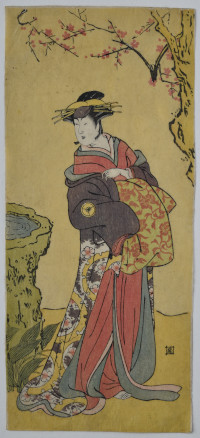
Click here to view image full size.
The actor Iwai Hanshiro IV probably in a new year Soga play. Unidentified publisher, published c late 1780s.
Fine impression. Exceptional colour. Fine condition.
Status: Sold
Torii KIYOMASU II (Fl. c 1720s -1760)
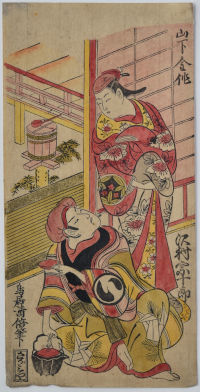
Click here to view image full size.
An exceptional Primitive showing the onnagata actor Yamashita Kinsaku I looking down at the actor Sawamura Sojuro I who is holding a kettle and teacup. Published by Sagami-ya Yohei c late 1720s.
Very good impression. Urushi beni-e with hand-applied colour: Tan, yellow, light and dark beni and green. Lacquered sumi over an embossed pattern and gold powder. Minor soil and small nick out of bottom edge, otherwise very good condition. Signed Torii Kiyomasu hitsu.
Status: Sold
Torii KIYOTOMI (FL. c 1720 -1740)
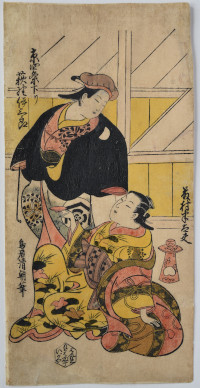
Click here to view image full size.
The actor Ogino Isaburo I looking down on the onnagata actor Fujimura Handayu II. An inscription above Ogino Isaburo states: Kyo Shijo kudari, “Coming from Shijo (Fourth Street) from the Capital.” Indicating the actor was on tour in Edo. Kyoto was considered the capital at that time and the Kabuki theatre was located on Fourth Street in Kyoto. Published by Igaya Kan’emon (Bunkido) c mid 1720s.
Very good impression. Urushi beni-e with hand-applied colour: Tan, yellow, light and dark beni and blue. Lacquered sumi over an embossed pattern and gold powder. Some soil and expertly repaired wormage, otherwise very good condition. Signed Torii Kiyotomi hitsu.
Status: Sold
Tamura SADANOBU (Fl. c 1720s-1730s)
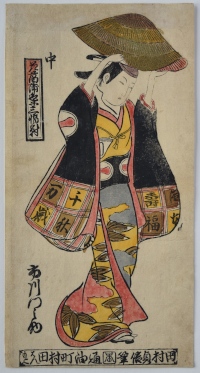
Click here to view image full size.
The An artist who seems to have specialised in triptychs. Shows the actor Ichikawa Monnosuke I shielding his head with a large sedge hat (kasa). The middle sheet (naka) of a triptych with title: Hana shobu irotagai sannpukutsui, “A Triptych of Irises in Alternating Colours.”(Possibly following the colours irises come in: Blue, purple, white.) On the sleeves are the auspicious characters denoting long life. Published by Murataya Jirobe (Eiyudo), c mid 1720s.
Very good impression. Urushi beni-e with hand-applied colour: tan, blue and beni. Lacquered sumi over an embossed pattern and gold powder. Slight loss of the sumi, otherwise very good condition. Signed Tamura Sadanobu hitsu.
Status: Sold
Torii KIYOMASU II (Fl. c 1720s -1760)
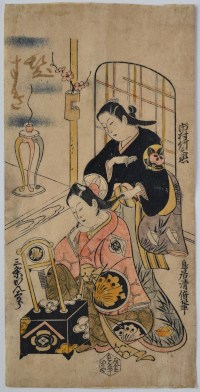
Click here to view image full size.
The onnagata actor Ichimura Takenojo IV standing and combing the hair of a fashionable young man played by Sanjo Kantaro II. Above, left, is the title printed in gold: Kamisuke, “Hair-combing.” These romantic scenes show the tenderness and love between a man and a woman. There is another version of this scene with the same actors by Okumura Toshinobu. Published by Igaya Kan’emon (Bunkido) c early 1730s.
Very good impression. Urushi beni-e with hand-applied colour: Lilac, beni and yellow. Lacquered sumi over an embossed pattern and gold powder with sprayed blue bands around title. Light soil and small expertly repaired wormhole, otherwise very good condition. Signed Torii Kiyomasu hitsu.
Status: Sold
Torii KIYOMASU II (Fl. c 1720s -1760)
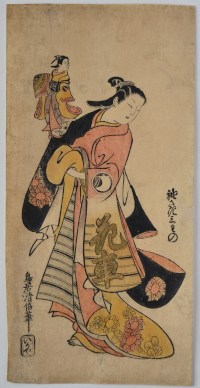
Click here to view image full size.
Shows the actor Sodesaki Miwano I as a proprietress of a house of assignation (kasha). He holds a puppet of the actor Ichikawa Monnosuke I dressed as a fashionable young man visiting the pleasure quarter holding a sedge hat to hide his face. Published by Igaya Kan’emon (Bunkido) c late 1720s.
Very good impression. Urushi beni-e with hand-applied colour: beni, yellow, lilac and pale green. Lacquered sumi over an embossed pattern and gold powder. Light soil and expertly repaired wormage, otherwise very good condition. Signed Torii Kiyomasu hitsu.
Status: Sold
Torii KIYOMASU II (Fl. c 1720s -1760)
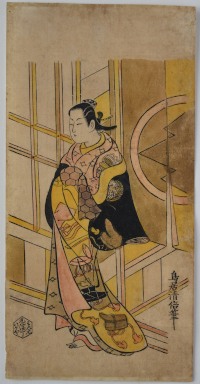
Click here to view image full size.
Shows a high-class courtesan emerging from a tea-house with slashed curtains. Possibly one sheet of a triptych. Published by Igaya Kan’emon (Bunkido) c mid 1720s.
Very good impression. Urushi beni-e with hand-applied colour: tan, light beni, light green and yellow. Lacquered sumi and gold powder (mostly lost). Light soil and expertly repaired wormage, otherwise good condition. Signed Torii Kiyomasu hitsu.
Status: Sold
Okumura TOSHINOBU (Fl. c 1717-1750)
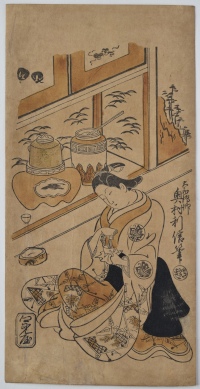
Click here to view image full size.
Shows a beauty whisking tea in front of an alcove. Published by Emiya Kichiemon c late 1720s.
Very good impression. Urushi with hand-applied tan colour. Lacquered sumi over an embossed pattern. Browned and some thinned areas, otherwise good condition. Signed Yamato gashi Okumura Toshinobu hitsu.
Status: Sold
Tsukioka YOSHITOSHI (1839-1892)
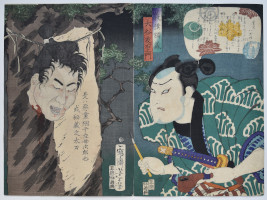
Click here to view image full size.
A diptych showing the actor Otani Tomoemon V as the loyal servant Gakuzo (aka Inukawa Sosuke Yoshito, one of the eight Dog half-brothers), brush in hand, having just hung the decapitated head of the evil Aboshi on a tree and written beside it: Kore ha akuto Aboshi Samojiro nari. Aruiwa hizo tachi, “This is the villain Aboshi Samojiro… He [stole] a treasured sword [Murasame – the treasured sword of the Ashikaga family].” Shows a scene from an episode in Part III, volume 5 of the Satomi Hakkenden no uchi, “Tales of the Eight Dogs of the Satomi Clan.” The macabre tale, written by Kyokutei Bakin (1767-1848) in 98 chapters and 106 booklets, revolves around the eight offspring of a supernatural marriage between a princess and her father’s dog and their commitment to restore the fortunes of the samurai house of Satomi. Published by Tamaya Sosuke 1868. Very rare: Keyes in his dissertation on Yoshitoshi lists just the right sheet from an oban series, presumably the print in the Philadelphia Museum of Art, ART568220, and another impression of just the right sheet is owned by Tateyama City in Chiba Prefecture.
Very good impression, colour and condition. Signed Kaisai Yoshitoshi hitsu. (Keyes attributes this print to Yoshitoshi as he hadn’t seen the left sheet.)
Status: Sold
Katsushika HOKUSAI (1760-1849)
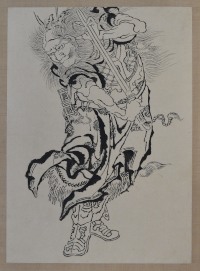
Click here to view image full size.
An original drawing, sumi on thin paper, 14.5 x 10.5 in; 37 x 27 cms, laid onto Japanese card. Shows a standing warrior with his sword drawn: A common subject in Hokusai’s oeuvre.
In very good condition.
Status: Sold
Isoda KORYUSAI (1735-1790)
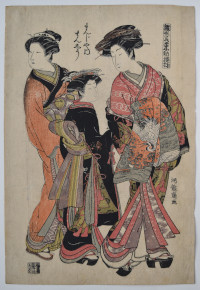
Click here to view image full size.
Manjiya uchi Manshiu, “Manshiu of the Manjiya [Brothel or House]” from a set: Hinagata wakana no hatsu moyo, “New Year Designs as Fresh as Young Leaves.” One of the great 18th century sets comprising at least 140 prints of consistent quality throughout. Shows the oiran with her two kamuro. Published in the late 1770s by Eijudo with some designs by Juzaburo.
Fine impression and colour. Slight creasing, otherwise very good condition. On heavy hosho. Signed Koryusai ga.
Status: Sold
Kitao MASANOBU (Santo KYODEN) (1761-1816)
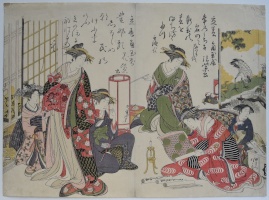
Click here to view image full size.
One double-oban design from the most sumptuous album ever produced: Yoshiwara keisei: Shin bijin awase jihitsu kagami, “A Mirror of New Yoshiwara Courtesans with Samples of Their Calligraphy.” Published by Tsutaya Juzaburo, 1784. Shows courtesans viewing calligraphic scrolls. Seven double-oban designs were published in album form, although the original intention was for a larger set. Signed on two sheets Kitao sensai Masanobu.
Fine impression and colour. Centre fold (as always), otherwise very good condition.
Status: Sold
Utagawa KUNIYOSHI (1797-1861)
Click here to view image full size.
A complete triptych showing beauties in boats on the Sumida River. Shubi no matsu, “Successful-deal Pine Tree” from a set Edo meisho somoku-zukushi, “Notable Sights Famous for Grass and Trees in Edo.” This famous pine was blown down during the An’ei era (1772-1780); its successor died during the Ansei era (1854-1859); the third died at the end of the Meiji era (c 1910). There is also the Hiroshige view of this subject from the 100 Views of Edo. Published by Ebiya Rinnosuke (Kaijudo), 1845.
Very good impression. Fine colour and condition. Full size. Another state has darker water and variegated cartouche. Signed Cho-o-ro Kuniyoshi ga.
Status: Sold
Ichiryusai HIROSHIGE (1797-1858)
Click here to view image full size.
One of Hiroshige’s most beautiful triptychs: Sumidagawa setchu no zu,“The Sumida River in Snow” from a series Edo meisho shiki no nagame, “Views of the Famous Places of Edo in the Four Seasons.” Shows a ferry landing on the Sumida with a beauty disembarking from a boat and another pair ready to board. Published by Maruya Jinpachi, c 1847-8. Rare.
Very good impression and colour. Horizontal centre fold, otherwise good condition. Signed Hiroshige ga.
Status: Sold
Utagawa KUNISADA (1786-1864)
Click here to view image full size.
A lively design showing Ichikawa Danjuro VII in the role of the loyal warrior Arajishi Otokonosuke Terumitsu fighting a giant rat in the cellar beneath the women’s quarters of the Ashikaga Palace. This scene, Yukashita no Ba, is from the play Date kurabe okuni Kabuki performed at the Kawarasaki-za Theatre, 3/1829. Shortly afterwards, the rat escapes down a hole in the hanamichi pathway, only to re-emerge in a cloud of smoke as the arch-villain and master of the black arts, Nikki Danjo. Published by Eikyudo (Yamamoto Kyubei) 1829.
Fine impression, colour and condition on an extra large sheet of hosho. Signed Gototei Kunisada ga.
Status: Sold
SESSHUNSAI (Dates unknown but active c 1800)
Click here to view image full size.
An extremely rare early Osaka hosoban showing the actor Asao Tamejuro II (1779-1806) standing before a broken barricade in the role of Yamashiro Kantsubo in the play Meiboku sendai hagi. This artist and print appear to be unrecorded. Published by Houki (Honya Kichisai), c early 1800. A wonderful design. Many thanks to Hendrick Luhl for his help on this print.
Very good impression and colour. The fujitive background aobana, dayflower pigment, intact except for one small area affected by moisture visible au verso. Very good condition. Signed Sesshunsai ga with seal unread.
Status: Sold
Jokei RYUKOSAI (Fl. c 1772-1816)
Click here to view image full size.
The most important and influential Osaka artist of the late eighteenth century. An innovator whose style may well have influenced such artists as Shunei and Sharaku. His prints – mostly hosoban – are all of the utmost rarity. Indeed, it is thought they originally formed triptychs but, so far, no complete design has been located. The oban design offered here is even rarer, there being only two other impressions known: Illustrated in colour, pl. 13, in Kamigata Ukiyo-e Nihyaku-nen Ten, “200 Years of Kamigata Ukiyo-e,” Susumu Matsudaira, 1975; and pl. 43, p. 56, catalogue of exhibition Ukiyo-e of the Kamigata Area at the Osaka Museum of History and Yamaguchi Prefectural Hagi Uragami Museum, Kitagawa Hiroko, 2014. Shows five actors. From right to left (rear): Nakamura Kyojuro, Arashi Sangoro III, Kataoka Nizaemon VII and (front): Asao Tamejiro I, Ichikawa Danzo IV. Published c 1790 by Ki.
Fine impression. Very good colour. Small areas of contemporary hand colouring to face and costume of Tamejiro. Slight folds and small sumi mark bottom left, otherwise very good condition. Probably full size. Signed Ryukosai ga.
Status: Sold
Jokei RYUKOSAI (Fl. c 1772-1816)
Click here to view image full size.
The most important and influential Osaka artist of the late eighteenth century. An innovator whose style may well have influenced such artists as Shunei and Sharaku. His prints – mostly hosoban – are all of the utmost rarity. Indeed, it is thought, as here, that they originally formed triptychs but, so far, no complete design has been located. The unsigned left panel of a triptych published 1/1793 showing Onoe Shinshichi I (Fujaku) as Isshiki Yukinokami in the play Keisai yanagi sakura. The play involves the rescue of the Ashikaga Shogunate through the efforts of Yukinokami in uncovering a usurper’s plot. The hero stands in a snowy garden holding a fragment of a handscroll he has been found reading. Of the utmost rarity: Only a few impressions are known and there are two states: As here without role above and published by Osakaya Sashichi and with the calligraphy and published by Shiocho.
Fine impression, colour and condition.
Status: Sold
TOGAKUSAI (Active c 1782)
Click here to view image full size.
An extremely rare and early Osaka hosoban (probably unrecorded) showing the actor Kano Hinasuke I (who later became Arashi Koroku III) standing on large geta and holding an umbrella. Published by Shioki-han (Shioya Kisuke), c 1782. The poem above is signed using the actor’s hango Arashi Minshi. Only a few designs are known by this artist. Many thanks to Hendrick Luhl for his help on this print.
Very good impression and colour. Some wear and tear which has been skilfully restored. On very thin paper. Signed Togakusai hitsu with seal Sadakuni.
Status: Sold
Utagawa KUNISADA (1786-1864)
Click here to view image full size.
An exceptionally rare original double-sided woodblock. On one side is the key-block showing Ichikawa Danjuro VII as the strongman, “chikaramochi,” Ura no Kingo. On the other is the key-block showing Iwai Kumesaburo II as the female acrobat, “karuwazashi,” Tamamoto Kosan. The play is Fujikawabune noriai banashi performed at the Nakamura-za Theatre, 5/1826. The block measures 8.5 x 10.75 x .75 in; 21.6 x 27.3 x 2 cms. The two images signed Gototei Kunisada ga. In very good condition but with obvious minor damage. Sold “as is.”
Status: Sold
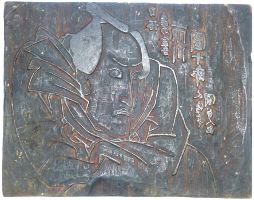
Click here to view image full size.
Kubo SHUNMAN (1757-1820)
Click here to view image full size.
A rare surimono showing new year festivities before a large screen depicting Mount Fuji at sunset. A versatile and highly talented artist working in various mediums, Shunman produced (and cut and printed) some of the finest surimono. Published c 1810s. I cannot, at the moment, locate another impression.
Fine impression and colour with extensive gold and silver. Fine condition. Sealed Shunman bottom right.
Fine impression and colour with silver and gold. Light backing, otherwise very good condition. Signed Shokyuko Shuntei ga.
Status: Sold
Totoya HOKKEI (1780-1850)
Click here to view image full size.
An exceptionally rare surimono showing salt gatherers on a beach, their huts behind them and Mount Fuji towering over the horizon. Published c 1820s. I cannot, at the moment, locate another impression.
Fine impression with gold clouds and Fuji heavily blind-printed. Fine colour. Minimal soil, otherwise very good condition. Si8ned Hokkei.
Status: Sold
Kitagawa UTAMARO (1753-1806)
Click here to view image full size.
No. 7 from a set of 12 prints: Joshoku kaiko tewazagusa, showing women engaged in the sericulture (silkworm) industry. This was traditionally the domain of women. The colour scheme is red-avoiding (murasaki-e) using predominantly purple. This stage of the process shows the metamorphosis – the winged moth stage – when silkworms are used to lay eggs. This set is taken verbatim from the Shunsho/Shigemasa set of chuban prints, Kaiko yashinai-gusa. (See elsewhere on this site for a Shunsho example.) Published 1798-1800 by Tsuru-ya Kiemon.
Fine impression. Fine colour, perfectly retained. Very good condition; full size. Signed Utamaro hitsu.
Status: Sold
Utagawa KUNIYOSHI (1797-1861)
Click here to view image full size.
A beauty in sumptuous clothing from a fine set of seventy numbered prints with title: Sankai medetai zu, “Excellences of Mountain and Sea.” The set compares busts of beautiful women with various products and occupations from the provinces of Japan. This is number 3, Tamba, and shows men fishing at night with the aid of flares. The set published 1852 by Sano-ya Kihei.
Very fine impression and colour with strong burnishing on collar. Fine condition. Signed Ichiyusai Kuniyoshi ga.
Status: Sold
Utagawa KUNIYOSHI (1797-1861)
Click here to view image full size.
A beauty reading a program while a cat dozes beside her. From a fine set of seventy numbered prints with title: Sankai medetai zu, “Excellences of Mountain and Sea.” The set compares busts of beautiful women with various products and occupations from the provinces of Japan. This is number 19. Catching octopuses, Takasago in Banshu [Harima] Province. The set published 1852 by Sano-ya Kihei.
Very good impression and colour. The cat’s fur blind-printed. Light album backing, otherwise good condition. Signed Ichiyusai Kuniyoshi ga.
Status: Sold
Utagawa KUNIYOSHI (1797-1861)
Click here to view image full size.
Token Gonbei using a mirror to pluck his forehead (hitai). The style became known as Token hitai. From a set: Kuniyoshi moyo shofuda tsuki genkin otoko, “Men of Ready Money with True Labels Attached, Kuniyoshi Style.” These otokodates (a word that is difficult to translate but was a chivalrous commoner, a fashionable man-about-town, street-wise and ready to assist the oppressed). Gonbei is said to have beaten a barking token (Dutch hunting dog) to death with his bare hands – thus he got his name. Published c 1845 by Iba-ya Kyubei.
Very fine impression. Fine colour. Light album backing, otherwise fine condition. Signed Ichiyusai Kuniyoshi ga.
Status: Sold
Utagawa KUNIYOSHI (1797-1861)
Click here to view image full size.
Sasai Kyuzo Masayasu (Sakai Kyuzo Narashige) enveloped in smoke and disintegrating before a volley of musketry at the battle of the Anegawa (1570). From the set Taiheiki yeiyuden, “Heroic Stories of the Taiheiki. A history of the wars of the loyalist Nitta and Kusunoki families against the Ashikaga war-lords during the second quarter of the fourteenth century. But in fact the subject of this set of fifty prints (this being 12, but not numbered) is the civil war of the late 16th century. Censorship restrictions imposed in the 1840s prevented publishers from illustrating historical subjects from the Tensho era 1573-92 onwards, so the publishers circumvented this by slightly altering the names of the historical figures. Published 1848-9 by Yamamoto-ya Heikichi. Robinson S62.36. The best design from the set.
Fine early impression. Fine colour. Slight nibbling to left edge, otherwise very good condition. Fine impression. Fine colour. Slight trimming, otherwise very good condition. Signed Ichiyusai Kuniyoshi ga.
Status: Sold
Katsushika HOKUSAI (1760-1849)
Click here to view image full size.
A poem by Onakatomi no Yoshinobu Ason from Hyakunin isshu uba ga etoki, the “Hundred Poems explained by the Wet Nurse.” Published by Nishimuraya Eijudo and Iseya Eijudo c 1835/6. Although obviously intended to be a set of 100 prints, only 27 are known plus drawings for the others. The poet speaks of his love being like a fire kept by guards at the Imperial Palace: It only burns hot at night. Shows a group of sleepy imperial guards with the fire burning low. The poet and servant are seen on the distant hill.
Very fine early impression. Fine colour and condition. (The small white area without colour top left should appear on every untrimmed genuine impression.) Signed Zen Hokusai manji (the manji seal black).
Status: Sold
Katsushika HOKUSAI (1760-1849)
Click here to view image full size.
A poem by Kiyowara no Fukayabu from Hyakunin isshu uba ga etoki, the “Hundred Poems explained by the Wet Nurse.” Published by Nishimuraya Eijudo and Iseya Eijudo c 1835/6. Although obviously intended to be a set of 100 prints, only 27 are known plus drawings for the others. The poet speaks of the shortness of the summer night and asks if the moon is still overhead or hidden by clouds. Shows an evening on the Sumida River with a large pleasure boat accompanied by a smaller craft and a vessel providing food.
Fine early impression. Fine colour. Slight centre fold, otherwise good condition. Signed Zen Hokusai manji (the manji seal black).
Status: Sold
